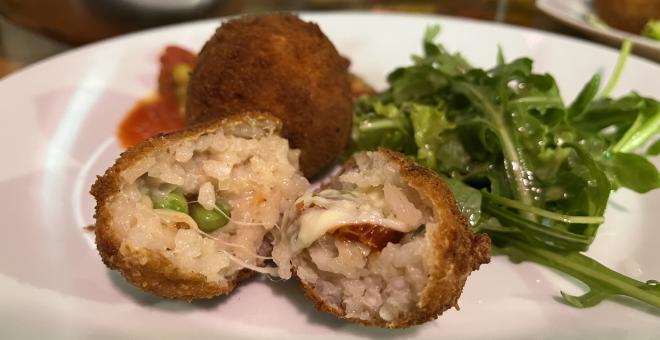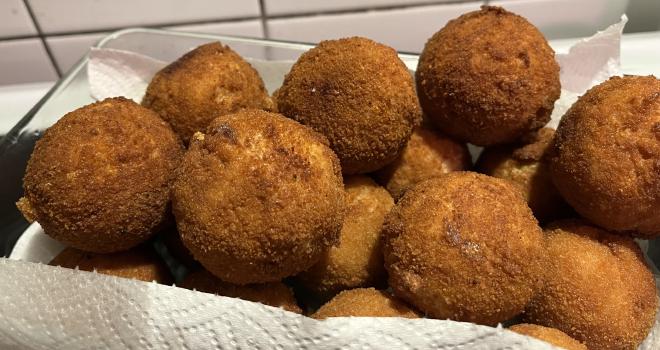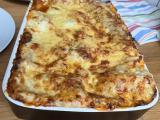Arancini - Italian Rice Balls
Table of Contents
Jump to Recipe
Jump to Carbon Footprint
Arancini are a classic of Italian cuisine and the perfect leftovers: If you have some risotto from the day before, you’re halfway there.
Originally from Sicily, arancini means “little oranges” - because their shape and colour are slightly reminiscent of the fruit. They are basically risotto balls with a simple filling, which are then breaded and deep-fried. If you don’t have a deep-fryer (like me), you can just fry them in a high sauce pan.

I have used a filling of tomatoes, peas and mozzarella below, but there are countless variations - with ragù, spinach and ricotta, herbs or grilled vegetables: the little rice balls are simply delicious and work well as a starter, main course (perhaps with a salad) or even as finger food. If you make too much filling, you can easily turn it into a side dish sauce.
My personal favourite filling is mozzarella: when warm, it pulls strings when you bite into it, which is why the balls are sometimes compared to old-fashioned telephone cables in Italy, and are therefore called “supplì al telefono”.
The finished arancini have a wonderful combination of a slightly crispy crust and a great soft centre. One of my all-time favourite dishes!
The recipe in this article is based on the one in Claudio del Principe’s vegetarian Italian cookbook (publisher’s page, written in German), from which I have also already cooked the Parmigiana di Melanzane.

Recipe #
Arancini - Risotto Balls with Tomato and Pea Filling
60 minutes
2 portions
Ingredients #
For the rice (if you don’t have leftover risotto):
- 1/2 small onion
- 1 clove of garlic
- 1 tablespoon of oil
- 150-200 g risotto rice
- 50 g white wine
- 200-300 g water
- 1 teaspoon vegetable stock
- 20 g butter
- 20 g parmesan
For the filling:
- 1/2 small onion
- 2 tablespoons olive oil
- 1 tablespoon tomato puree
- 50 g sieved tomatoes
- 50 g peas
- Salt, pepper
- 35 g mozzarella
For the rice balls:
- 250 g risotto rice from the day before (if making fresh, see above)
- 50 g flour
- 1 egg
- 75 g breadcrumbs
- Oil for deep-frying
Directions #
- If you don’t have ready-made risotto from the day before, make it fresh (otherwise you can skip to the next step): Peel and chop the onion and garlic, then sauté in the oil. When the onions are soft, add the risotto rice, fry for about 30 seconds and deglaze with wine. Add water so that the rice is just covered - add the vegetable stock the first time. Keep stirring to prevent the rice from burning. Reduce the heat to low to medium and continue to add water until the rice is cooked. At the end, turn off the heat and stir in the butter and grated Parmesan. For the arancini, the risotto rice must be completely cold.
- The next step is to prepare the filling for the arancini: Peel and dice the onion and fry in olive oil. When they are translucent, add the tomato pulp and fry briefly. Add the strained tomatoes and peas, reduce a little and season with salt and pepper. Drain the mozzarella and cut it into small cubes, but don’t add it to the sauce, keep it separate.
- Prepare the breadcrumb coating: Put the flour in a shallow bowl. Crack the egg into a deep dish and whisk lightly. Pour the breadcrumbs into another shallow dish.
- To form the arancini, place about a tablespoon of risotto rice in the palm of your hand and make a hollow. Place about a teaspoon of filling and some mozzarella in the centre, then carefully seal the risotto rice around it and shape into a compact ball about the size of a golf ball. Roll the rice ball in the flour, then in the egg and finally in the breadcrumbs. Repeat until all the rice and filling have been made into balls.
- Heat the oil in a high sauce pan, checking that it is not too hot (smoke point). Gradually fry the breaded rice balls. Leave to cool and serve.
Carbon Footprint #
In total, two portions of arancini have an estimated carbon footprint of 2722 g.
This ranks it number 52 out of 57 recipes published on the blog so far in terms of estimated carbon footprint.
In other words, it is one of the five recipes with the worst carbon footprint. 😱Several aspects of the individual ingredients stand out: The most obvious is the emissions from the frying oil, which accounts for more than a third of the emissions caused by the recipe. One way to reduce this effect is to filter and reuse the oil. One aspect that is difficult to avoid is processing: it takes about 2.5 kg of plants (rapeseed, sunflowers) to produce one litre of oil. Another aspect is dairy: Although we use only small amounts of butter, parmesan and mozzarella (together around 7% of the weight), they account for around 20% of the carbon footprint of the dish. A third factor is rice: The usual terraced farming system releases a relatively large amount of methane from the soil, which has a relatively high climate impact. Other forms of rice cultivation would therefore help the planet. A fourth and perhaps unsurprising factor is water: Risotto requires a lot of liquid for the rice to absorb, which fortunately has an almost negligible carbon footprint.
| ingredient | carbon footprint per kg | carbon footprint (in g) for 2 servings | % of ingredients | % of CO2 emissions |
|---|---|---|---|---|
| Onion | 0.2 | 12 | 5% | 0% |
| Garlic | 0.5 | 1 | 0% | 0% |
| Oil | 3.2 | 32 | 1% | 1% |
| Risotto rice | 3.1 | 543 | 14% | 20% |
| White wine | 1.0 | 50 | 4% | 2% |
| Water | 0.0 | 0 | 20% | 0% |
| Vegetable stock | 0.3 | 2 | 0% | 0% |
| Butter | 9.0 | 180 | 2% | 7% |
| Parmesan cheese | 6.3 | 126 | 2% | 5% |
| Oil | 3.2 | 64 | 2% | 2% |
| Tomato paste | 4.3 | 43 | 1% | 2% |
| Sieved tomatoes | 1.8 | 90 | 4% | 3% |
| Peas | 1.2 | 60 | 4% | 2% |
| Salt | 0.7 | 1 | 0% | 0% |
| Pepper | 1.2 | 1 | 0% | 0% |
| Mozzarella | 6.4 | 225 | 3% | 8% |
| Flour | 0.9 | 45 | 4% | 2% |
| egg | 3.0 | 150 | 4% | 6% |
| Breadcrumbs | 0.6 | 45 | 6% | 2% |
| Oil for deep-frying | 3.2 | 960 | 24% | 35% |
| Cooking risotto | 33 | 1% | ||
| Fry the filling | 4 | 0% | ||
| Frying rice balls | 56 | 2% |

